How to remove fungus in the bathroom: the best folk and professional methods
Mold stains can often be found on the walls of rooms with high humidity, which pose a threat to the health of residents.
Using the information on how to remove fungus in the bathroom and other rooms, you can get rid of pathogenic microflora using folk or professional remedies. In this material we will talk about the types of mold and the most effective ways to combat it.
The content of the article:
Common Types of Mold
Almost every housewife has had to deal with black spots, which are usually localized in the bathroom or other rooms with high air humidity.
This type of plaque should not be confused with dirt; it is usually caused by certain types of microscopic organisms.

Three common types of microflora can parasitize the walls, floors and ceilings of rooms.
blue fungus. This type of protozoan organism is capable of reproducing only on wood, preferring structures made of pine.
Blue fungus can be found in baths and saunas built from coniferous trees, but it does not threaten the inhabitants of city apartments.
Rotting bacteria (bacterial, brown, white rot) are also capable of multiplying only on wood, causing the breakdown of cellulose fibers.
It is extremely difficult to remove these microorganisms by stopping the process of wood destruction. You can only take action in advance by treating the material with special fungicidal solutions.
Black mold. The greatest danger to people is mold fungi, which form black spots. This group includes several representatives of microflora (Chaetomium, Ulocladium, Aspergillus and others).
Capable of settling black mold not only on organic surfaces, but also on ceramic tiles, concrete, paint layers, and brickwork.

Such microflora should not be left without attention; it is advisable to take immediate measures to eliminate it.
Why is fungus on walls dangerous?
Mold that appears in rooms harms building structures and also negatively affects human health. A fungus that has settled on walls or ceilings gradually destroys the material on which the colony has settled.
This can lead to peeling of plaster, paint and varnish coatings, and in advanced cases, even the formation of cracks in the walls.
If proper measures are not taken, partial or complete destruction of individual building elements and even collapse of surfaces may occur. Pathogenic microflora has an extremely harmful effect on the human body, causing a whole “bouquet” of various health problems.
Mold is directly related to the following ailments:
- general exhaustion of the body;
- dermatoses, mycoses and a number of other skin diseases;
- headaches, dizziness;
- diseases of the respiratory system (from rhinitis and sinusitis to pneumonia and asthma);
- upset stomach, nausea;
- articular rheumatism and other problems of the musculoskeletal system.
Prolonged exposure to mold can lead to severe damage to the lungs, kidneys, liver and other organs.
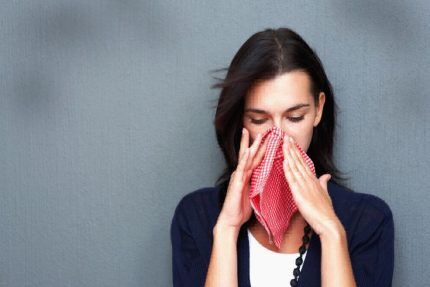
Elderly people, children, people with poor health, and patients undergoing chemotherapy or antibiotic treatment are especially sensitive to pathogenic microorganisms. IN this article You can read more about the harm that mold causes to the human body.
Mold prevention
Spores of various types of mold fungi are sprayed into the air of almost any room, but their germination and reproduction can only occur under certain conditions: humidity more than 30% and room temperature exceeding +20 ° C.
To prevent the formation of colonies of microorganisms, it is necessary to take all measures to eliminate these causes. The fight against humidity is especially important, since in a dry room mold will not develop even in a warm and hot microclimate.
To prevent mold stains from appearing indoors, a number of preventive measures must be strictly followed. You should ensure good air circulation in the room. As a rule, all multi-story buildings have a ventilation duct, but in older buildings it often fails to do the job.
Cleaning the canal will help correct the situation (this can be done by a specially called housing service worker) or additional installation fan.
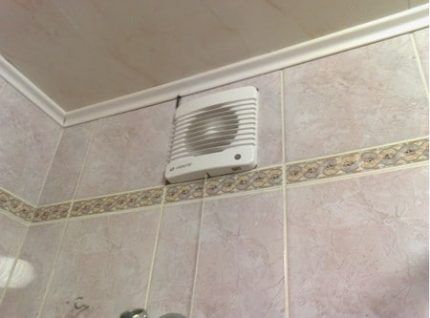
Even if the hood works well, after taking water treatments or washing, it is advisable to leave the bathroom doors open: this helps ventilate the room and remove excess moisture.
The space should not be overcooled: it is advisable to cover the walls of an insufficiently warm room with a layer of heat-insulating material.
If the heat transfer from the heated towel rail is weak, it is better to use additional heating equipment. This is especially true for the autumn-winter season, when the air temperature drops and humidity increases.
It is necessary to monitor the appearance of condensation on pipes, furniture and other surfaces of the bathroom. Try to immediately wipe off any spilled droplets with a rag or rag.
It is important to promptly identify and eliminate the causes of high moisture content in the room. It is necessary to constantly monitor the condition of faucets and plumbing fixtures, as well as connecting elements.
It is advisable to replace metal pipelines in the bathroom with plastic analogues: they are more resistant to leaks and are never covered in perspiration.
Don't forget to pay attention to the little things: stagnant water in toothbrush glasses can cause mold to form on their handles. Colonies of fungi can also settle on polymer curtains separating the bathtub or shower.
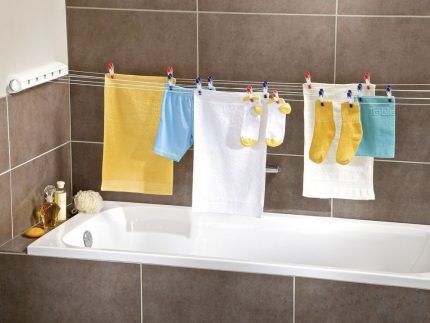
When renovating a bathroom, it is necessary to use special construction and finishing materials that prevent the appearance of fungus.
It is important to periodically carry out preventive treatment of surfaces, using traditional methods or household chemicals specifically designed for this purpose.
Mechanical method of removing fungus
Having discovered black spots in the room, the housewife usually takes a rag or a scraper, trying to wash off or scrape off the mold. To get an effective result, you need to know how to properly remove colonies of fungi in the bathroom.
First of all, detected areas of mold must be thoroughly moistened with water. This manipulation will prevent fungal spores from entering the air, which can cause new lesions.
Then you need to take a metal scraper or another similar tool (steel brush, drill with a grinding attachment), which will help thoroughly remove the affected area of the surface.
It is advisable to remove as much of the coating layer as possible (plaster, wallpaper, paint); For materials such as concrete and wood, milling is also possible.
In advanced cases, this method is not effective enough, since the mycelium can penetrate deeply even into inorganic surfaces, for example, hide under tiled cladding.
In this case, to solve the problem it will be necessary to carry out a major overhaul, including:
- removing walls from decorative coverings (ceramic tiles, wallpaper, layers of paint);
- removing lime or paint coating from the ceiling;
- replacement of floor finishing material.
When carrying out major repairs, it is imperative to treat all surfaces with fungus-killing agents.
Preparations (folk or professional) should be applied to an area larger in size than the area where the fungus is visible in order to remove micromycelium invisible to the naked eye.
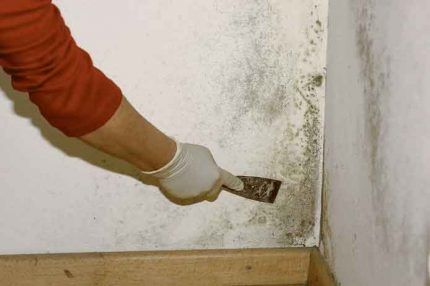
Each surface must be treated at least 2-3 times, each time waiting until the previously applied fungicidal preparation has completely dried. When performing repairs, it is advisable to use building materials with antifungal additives.
Traditional methods of mold removal
Since mold fungi have bothered residents for centuries, and household chemicals began to be produced not so long ago, the population has accumulated extensive experience in using a variety of means to destroy harmful microflora.
Among the most common drugs that have a pronounced effect are the following.
Option #1 - copper sulfate
An inexpensive, effective product that can be purchased at gardening, construction or hardware stores. Blue crystals are diluted in warm water in the proportion of 200-300 grams of powder per 10 liters of liquid, after which they are mixed well.
The process of treating the affected surface with the prepared solution is carried out in several stages:
- Traces of mold on the walls are cleaned using sandpaper or a spatula.
- The prepared areas are wiped with soapy water, which increases the effectiveness of the product used.
- The cleaned and washed surface is given time to dry.
- The wall is treated with copper sulfate (the solution can be applied using a kitchen sponge or sprayer).
- The surface is left to dry for 3-5 hours, after which diluted vitriol is again applied to it.
- Depending on the degree of fungal damage, the procedure is repeated 2-5 times.
For greater effectiveness, you can additionally add a tablespoon of vinegar to the vitriol solution.
Option #2 - chlorine-containing products
Solutions containing chlorine guarantee effective destruction of mold: they contain an aggressive component that kills most microorganisms. To combat fungus, you can use popular chlorine-containing preparations, which are often used in the household to bleach fabrics or clean plumbing fixtures, namely "Domestos", "Whiteness", "Sanitu" and others.
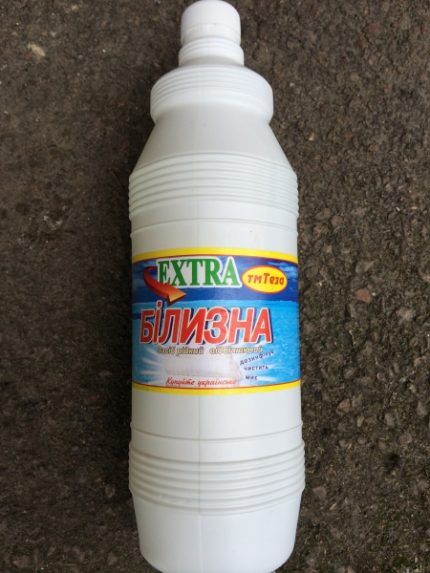
To combat mold colonies, the affected areas and the area around them are treated with a cloth moistened with undiluted product.
To treat tile joints, the preparation can be diluted with water in a 1 to 1 ratio, poured into a spray bottle and applied to the seams.
Option #3 - table vinegar
Almost every home has a 6-9% vinegar solution, which is widely used in cooking. At the same time, this product is a good antiseptic that perfectly destroys various types of microflora.
To combat mold you should:
- treat the affected area with table vinegar: just wipe a smooth surface (tile) with a sponge or rag dipped in liquid, and spray loose coatings (plaster, concrete, wood) with a spray bottle;
- leave the treated surface for 2-3 hours until dry;
- remove any remaining fungus with a brush;
- rinse cleaned areas thoroughly with water;
- Ventilate the room well to remove the pungent odor.
It should be borne in mind that in some cases vinegar may leave stains on the wall.
Other folk remedies for fungus
In addition, the following drugs can be used as antibacterial and fungicidal agents:
- Hydrogen peroxide. A widely used antiseptic, a 3% solution of which can be purchased at a pharmacy. The drug is non-toxic and has no pronounced odor. Caution is required during processing as peroxide has a clear bleaching effect.
- Ammonia. A good product for removing mold colonies from dense hard surfaces such as ceramic tiles or glass. To destroy microflora, the drug purchased at a hardware store is diluted with an equal amount of water, after which the mixture is applied to the infected area using a sponge or sprayer. The solution is left on the wall for several hours, after which the coating is washed well.
- Baking soda. A natural and safe household antiseptic that will help fight fungus. For treatment, a solution of a teaspoon of powder mixed in a glass of water is used. The surface on which the fungus is noticed is sprayed with the solution, or the wall is washed with a sponge soaked in the composition. It is not necessary to wash off the soda; you can safely leave it on the tiles or other surface.
- Tea tree oil. An environmentally friendly product with a strong, pleasant aroma, suitable for the prevention and destruction of small areas of mold. To use, you need to dissolve two teaspoons of essential oil in half a liter of water, which can be purchased at a pharmacy or specialty store. The resulting solution is sprayed onto areas where fungus is suspected. The product should not be washed off, but after treatment it is better not to enter the bathroom for 12 hours.
- Creosote. A yellowish liquid with a pungent odor made from tar is used as a solution in alcohol or ether. The product is recommended to be applied to concrete, tiles, plastic panels, bricks and other smooth, dense surfaces. After the product has dried, it must be washed off with soap and water.It is not advisable to use creosote to treat wooden structures, since the solution instantly penetrates into loose textures.
- Anthracene oil. A greenish liquid with a specific odor is produced from coal. Oil is considered a good prophylactic agent that prevents mold from appearing on walls.
- Borax. A mineral that is a natural antiseptic. To treat a surface with sprouted mold, you need to prepare a solution of 2.5 liters of liquid and 1 cup of borax. After cleaning the wall from stains, a fairly thick composition is applied to it using a rag. There is no need to rinse it off, but after drying, you can wipe the surface with dry paper to remove any protruding crystals. Another option: make a less concentrated solution (a full glass of borax and 4 liters of liquid), and then spray the affected area with a spray bottle.
- Camphor balls. To prevent fungal infection, camphor balls can be placed indoors.
- Iodine. Another preventive measure is iodine vapor. To do this, place a glass of water on a shelf in the bathroom, in which 10 mg of regular iodine tincture is diluted. It is advisable that there are no metal objects nearby, as volatile iodine vapors can cause corrosion.
Don't forget about cleaning cocktails.
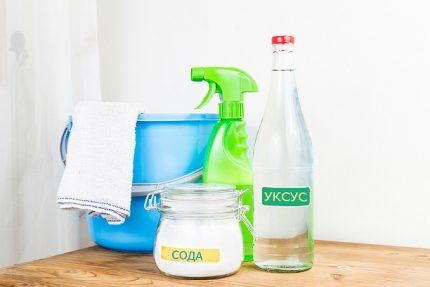
A preparation made from 4 parts water, 2 parts hydrogen peroxide, 1 part boric acid, 2 parts vinegar is also considered an effective remedy.
All components are mixed well, after which a rag or sponge is moistened with the mixture, which is used to treat all affected areas.
Professional methods of fungus destruction
If there is extensive fungal damage to bathroom surfaces, it is better to use professional mold removal methods.
Household chemicals
There are many different products available for sale to combat pathogenic microflora.
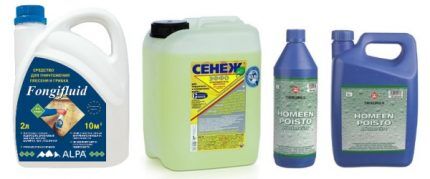
«Mil Kill"- an emulsion that contains an antiseptic that is safe for human health. The drug is especially recommended for treating complex surfaces made from materials with a finely porous structure.
The same product can be used to disinfect leaks, as well as to protect structures located in areas of high humidity.
«Isocide» is a line of drugs designed to destroy different types of microflora, typical for rooms with a high content of water vapor. The products can be used to treat substrates made of wood, stone, concrete, and can also be used as a base for the preparation of water-soluble paints.
Well Done – a modern antibacterial solution that suppresses the development of fungi, mold, and algae. It has a pronounced instant result and copes well even with large colonies of microorganisms.
Well suited for sanitizing internal and external surfaces, suitable for treating wooden, plastered or painted structures.
«Titanium» fungicide. A product designed to remove fungus and mold from interior and exterior paintwork without requiring removal of a layer of finishing material. The composition can also be used for prevention.
SZAVO (Savo). An effective drug designed to combat pathogenic microflora in rooms where it is difficult to get rid of high levels of water vapor (kitchens, bathrooms, basements, showers).
The manufacturer guarantees 100% destruction of mold, algae, and fungi. The product is extremely easy to use: it does not require pre-treatment of the surface or additional washing.
Astonish – an excellent preparation for removing mold from “light” surfaces that do not require scraping. It can be used to clean polymer shower curtains, plastic furniture, and tiles.
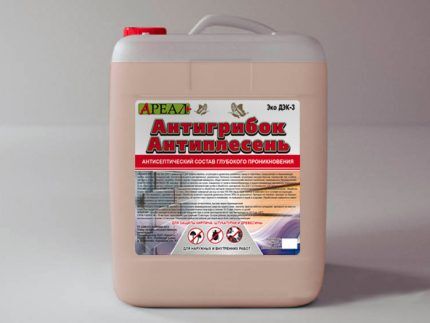
«Antifungal"is a universal remedy that can be used to treat areas affected by fungus or as a preventive measure. The drug is applied to almost all types of materials: brick, wood, concrete, plaster.
Dali - a completely transparent antiseptic preparation made on a water basis. Excellent for the prevention and elimination of fungus on wooden structures.
Domestic and imported manufacturers also produce a wide range of paints, grouts, primers and other types of building materials, which contain fungicidal components that guarantee surface protection.
There is another article on our website dedicated to choosing antifungal drugs, we recommend reading it too.
Sanitation and ionization of the room
To combat fungus in the bathroom, the affected areas are also treated with a stream of air, which is additionally enriched with ions and microelements.
Since the special equipment designed for this is quite expensive, the work is usually carried out by specially trained professionals.

To carry out large-scale mold removal work, aggressive chemicals are also used, the use of which requires special precautions. Treatment with such drugs is carried out by trained specialists.
To prevent the emergence and spread of fungal microorganisms, you should regularly sanitize important household premises:
Safety rules when processing premises
All mold removal procedures are considered dangerous types of work, since when they are performed, harmful fungal spores can come into contact with the skin and mucous membranes.
In addition, when treating surfaces, mostly potent substances are used, which can cause burns, poisoning and other negative reactions.

To prevent this, it is necessary to take special precautions.
When carrying out work you should wear:
- durable rubber gloves that protect your palms and wrists;
- respirators or respiratory masks;
- plastic glasses (preferably special ones that fit tightly to the eye sockets) that provide effective eye protection.
After completing the work, it is recommended to throw away the protective equipment used, primarily gloves and respirators.
When treating a bathroom, it is better to remove all small objects from the room, and cover large ones with a protective film, which should then be carefully collected and taken out.
Measures to destroy the fungus must be carried out in the absence of children and pets. It is advisable to ventilate the treated room well for 2-4 hours, after which it is better not to use the bathroom for 2-3 days.
Conclusions and useful video on the topic
The video below shows how to remove fungal colonies in the bathroom:
The fight against mold should be carried out constantly. After eliminating fungus in the bathroom using folk or professional remedies, it is important to follow all recommended preventive measures that will help avoid the appearance of new outbreaks.
Perhaps you know other effective ways to destroy fungus in the bathroom and have you tried them in practice? Please tell our site visitors about them. You can do this by leaving a comment on the article in the block below.




We have been fighting black mold for a long time - it is the most dangerous and tenacious reptile. Before our vacation, we left the washing machine closed, and after the trip we had these dark spots all over the rubber band and on the wall. Air is needed, regular ventilation to reduce humidity (difficult, especially in the bathroom). We brought her out in a few days, but I still sometimes inspect everything in the corners. The main thing is not to create a “steam room”; moisture and heat are what this mold loves!
Wow! I didn’t even know that this mold was so dangerous, not only for the walls and ceiling, but especially for my health. There is a black spot on the ceiling in the corner. It was impossible to get rid of him. I’ll try to test folk recipes for fighting mold. I especially liked the recipes using vinegar, baking soda, and hydrogen peroxide. These are the products that you always have at home, and are also inexpensive.
I had a similar situation. None of the traditional methods helped, so I had to use aggressive chemicals. It's called Olympus Stop Mold, and it might come in handy for you.
Is Olympus a means to fight? This is the same impregnation that is applied during construction in order to prevent in the future...
In a warm and humid room, such as a bathroom, it is very difficult to fight fungus. A good tool for repairs (even cosmetic ones) is used calcium carbide. Those. the solution that remains after gas welding or gas cutting is diluted with water and applied to the walls and ceiling.
A poisonous mixture, but it works flawlessly. If you then paint the surface with lime paints, the effect is guaranteed for many years. Tested by me for 8 years.